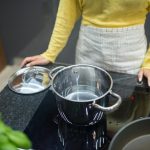
Induction cooktops have come a long way since debuting in the early 1980s. Initially costly and underperforming, they’ve now become mainstream thanks to efficiency improvements and lower prices. Even though they cook differently from gas or electric stoves, proper ventilation remains an important consideration.
🔍 How Induction Cooktops Work
An induction cooktop generates heat by creating a strong electromagnetic field beneath its smooth glass‑ceramic surface. When compatible cookware—typically cast iron or magnetic-grade stainless steel—is placed on top, the magnetic field induces heat directly in the pot. The cooktop surface stays cool, and efficiency often exceeds 85–90%, minimizing wasted energy.
🌫 Why Ventilation Still Matters with Induction Cooking
Even though induction generates less ambient heat or combustion byproducts than gas, normal cooking activities still produce:
- Steam from boiling water or sauces
- Grease and cooking vapors from sautéing
- Smoke when oils or food particles overheat
Without proper exhaust, these can lead to air quality issues, sticky buildup on walls or cabinets, and long‑term grease accumulation that becomes a fire hazard or ductwork clog.
🛠 Ventilation Recommendations for Induction Cooktops
Leading ventilation guidance (e.g., from the Home Ventilating Institute) advises the following for cooktops:
| Cooktop Location | Recommended Hood CFM |
|---|---|
| Against a wall | 40 – 100 CFM |
| Kitchen island | 50 – 150 CFM |
Choose a hood size and airflow capacity based on your stove’s width and layout. A powerful hood helps capture steam, smoke, and cooking odors effectively—regardless of cooktop type.
✅ Pros and Cons of Ventilation with Induction Cooktops
Advantages:
- Improved air quality
- Reduced grease and odor buildup
- Cooler, more comfortable cooking environment
- Helps keep cabinets and walls clean
Potential drawbacks:
- Slight increase in energy use
- May add upfront cost (range hood + installation)
- Sound level of fan may be noticeable depending on model
However, most kitchens benefit from some form of ventilation—even when using induction.
❓ FAQ: Ventilation and Induction Cooking
Q1: Do induction cooktops produce toxic gas?
A: No. Induction cooking doesn’t involve combustion, so there’s no carbon monoxide or soot.
Q2: If induction is so clean, can I just open a window instead of installing a hood?
A: A window helps sometimes, but cooking vapors tend to linger and settle—especially grease. A quality range hood is more effective in trapping and exhausting airborne particles.
Q3: Does the hood CFM rating change based on induction or gas?
A: No. Cooking volume—not cooktop type—drives ventilation needs. High-output stoves and heavy cooking deserve higher CFM.
Q4: Can I use a downdraft or recirculating hood with induction?
A: Yes, but recirculating systems are less effective at removing moisture and grease. Downdraft hoods work on islands but should meet appropriate airflow specs.
Q5: What size hood should I choose for a 30-inch induction cooktop?
A: Typically a 30- or 36‑inch range hood with at least 90 CFM rating (higher if you do heavy cooking with oils or stir-fry).
✅ Final Thoughts
Even though induction cooking produces less ambient heat and no combustion byproducts, adequate ventilation is still important. Proper airflow helps maintain kitchen cleanliness, prevents grease buildup, and ensures comfortable, odor-free cooking.
If you plan to install or already use an induction cooktop—especially in island configurations—investing in a suitable range hood with appropriate CFM is a smart move.

Leave a Reply
You must be logged in to post a comment.